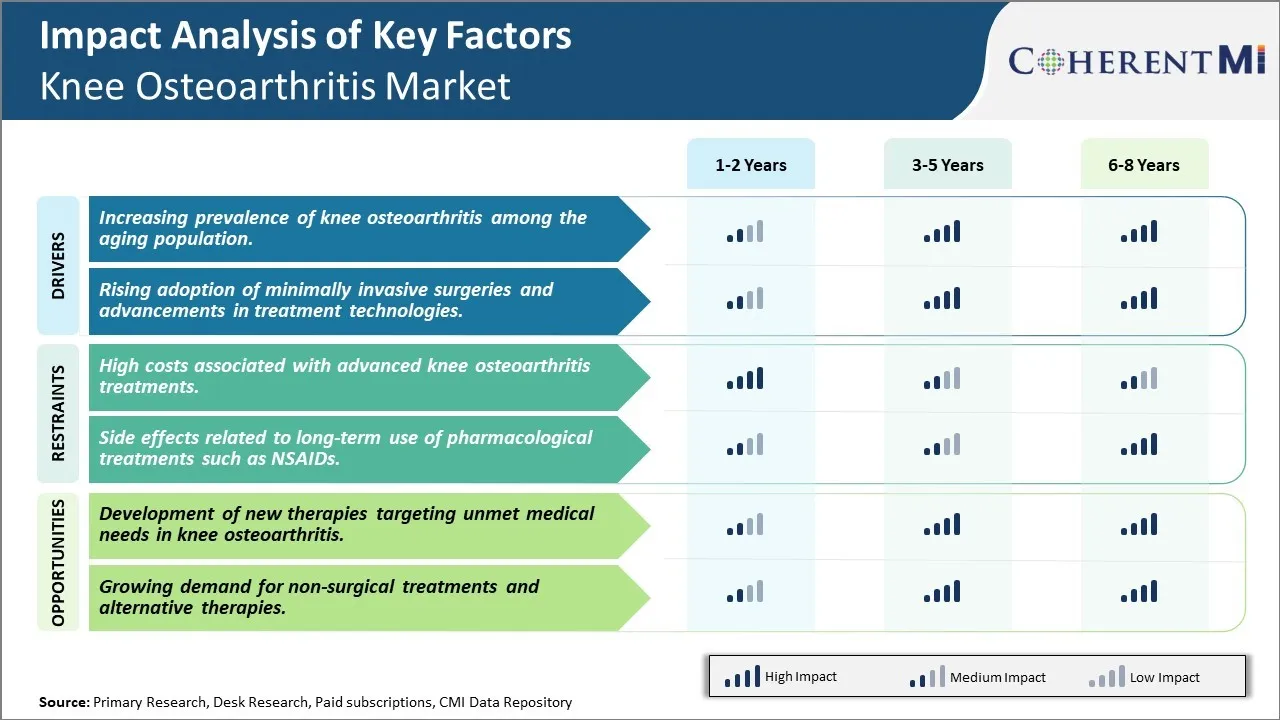Knee Osteoarthritis Market Trends
Market Driver - Increasing prevalence of knee osteoarthritis among the aging population
As life expectancy is increasing globally, populations are aging rapidly all around the world. The geriatric population which is aged 65 years and above is growing at an unprecedented rate. It is estimated that by the year 2050 worldwide, 1 in 6 people will be aged 65 years and above. With increasing age, the tissues in the body including cartilage starts wearing down naturally. Knee osteoarthritis predominantly affects this aging population as cartilage becomes thin and even wears away with time, leading to bones rubbing together causing pain, swelling and stiffness. Older age is the single biggest risk factor for knee osteoarthritis.
As the bones and cartilage in the knees undergo degenerative changes, mild to severe pain and movement limitation occurs. Simple daily tasks like walking, climbing stairs, kneeling etc become difficult. This greatly diminishes quality of life in older adults. Lack of enough physical activity further accelerates the degenerative knee condition. Sedentary lifestyle is rampant in developed nations especially where a majority of elderly population lead increasingly inactive lives. Advanced diagnosis through X-rays reveals bone spurs and loss of joint space in knees affected by osteoarthritis. In many cases, joint replacement surgeries are the only solution to alleviate pain and restore mobility.
Market Driver - Rising adoption of minimally invasive surgeries and advancements in treatment technologies
Over the past decade, there have been major technological leaps in surgical procedures and medical devices for treatment of knee osteoarthritis. Minimally invasive techniques like arthroscopy are becoming increasingly popular compared to traditional open knee replacement surgeries that involve larger incisions. Arthroscopy facilitates diagnostic assessment of knee problems through tiny incisions and cameras inserted in the joint. It also allows procedures like removal of loose bone or cartilage flaps, debridement of areas inflamed by arthritis and repairs of torn ligaments or meniscus with minimal downtime.
Additionally, new procedural innovations are refining rehabilitation outcomes of knee replacement surgeries. Robotics assisted procedures promote increased accuracy compared to manual implantation of prosthetic knees. Patient matched or customized implants based on 3D imaging and printing techniques of each individual's knee anatomy ensure best fit and structure of replacement components. Advance biologic treatment options involving mesenchymal stem cells, platelet rich plasma and supplements aim to reduce inflammation, slow disease progression and repair damaged cartilage. Wear resistant materials in newer generation prosthetics are designed to last longer. Remote digital monitoring systems also allow joint surveillance and early detection of post-surgical issues from patient's homes via wireless transmission of sensor data. Collectively, these clinic-technological factors are fueling rise in knee osteoarthritis treatment seeking behavior.

Market Challenge - High costs associated with advanced knee osteoarthritis treatments
One of the major challenges faced by the knee osteoarthritis market is the high costs associated with advanced treatments for patients with severe knee osteoarthritis. The escalating costs of joint replacement surgeries like knee replacement have made it inaccessible for many patients. Knee replacement surgery is considered as one of the most expensive orthopedic procedures, with the average total knee replacement surgery cost ranging between $30,000 to $60,000 in the United States. Additionally, advance treatment options like biologic drugs that target inflammation also come with very high price tags, limiting their usage. For instance, injections of anti-inflammatory biologics like intra-articular hyaluronic acid range between $500 to $2000 per treatment, requiring multiple doses for efficacy. The financial burden of such expensive treatments often deters patients from undergoing the procedure or therapy, resulting in delayed treatment and worse health outcomes. This substantial economic burden poses significant challenges to growth in the knee osteoarthritis market.
Market Opportunity - Development of new therapies targeting unmet medical needs in knee osteoarthritis
One major opportunity for growth in the knee osteoarthritis market lies in the development of new therapies that can address some of the unmet medical needs in knee osteoarthritis treatment. Currently available pharmacological therapies have limited efficacy in modifying the disease progression and mainly provide symptomatic relief. Further, joint replacement surgeries are highly invasive options considered only for end-stage disease. This leaves a significant need for the development of disease-modifying treatments that can slow cartilage deterioration and improve joint health. Companies are actively investing in research efforts exploring newer treatment modalities like gene therapies, cell therapies and tissue-engineered solutions that can potentially repair damaged cartilage. The success of such new treatment options in clinical trials would open up lucrative growth prospects by offering minimally invasive solutions to patients early in the disease course. Overall, the substantial unmet needs in managing the underlying pathology of osteoarthritis presents a major commercial opportunity for pharmaceutical companies and devices players in the knee osteoarthritis market.